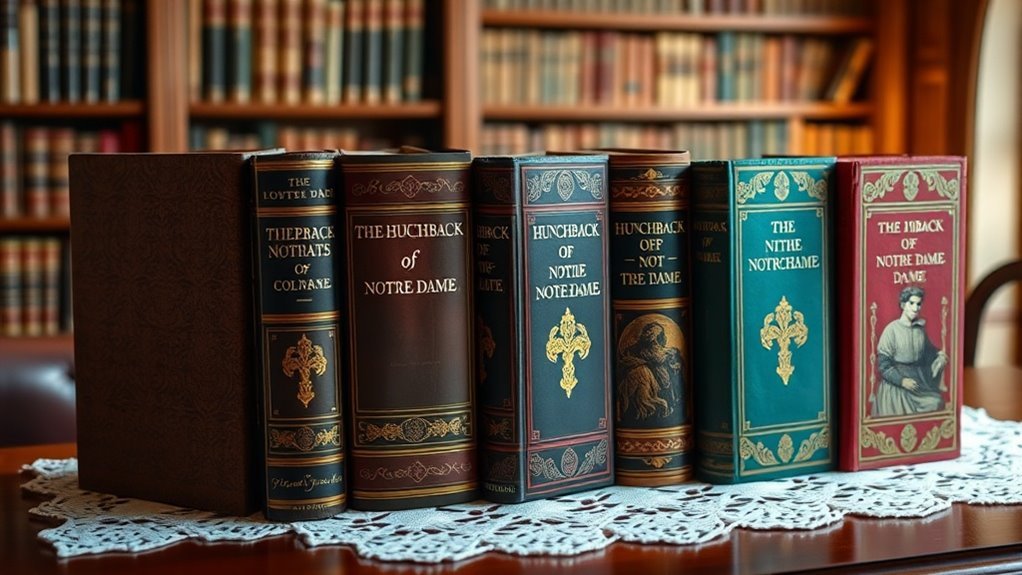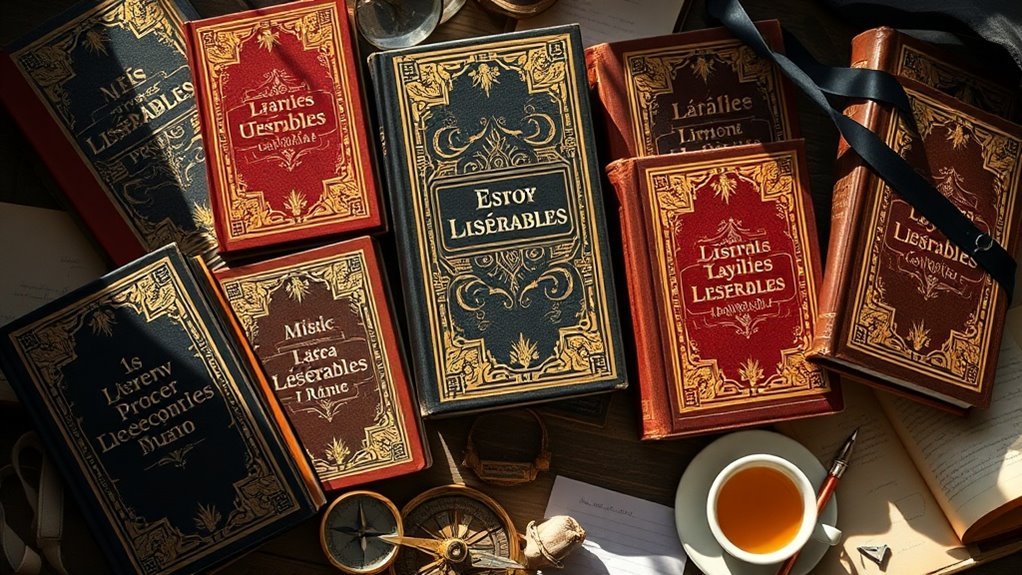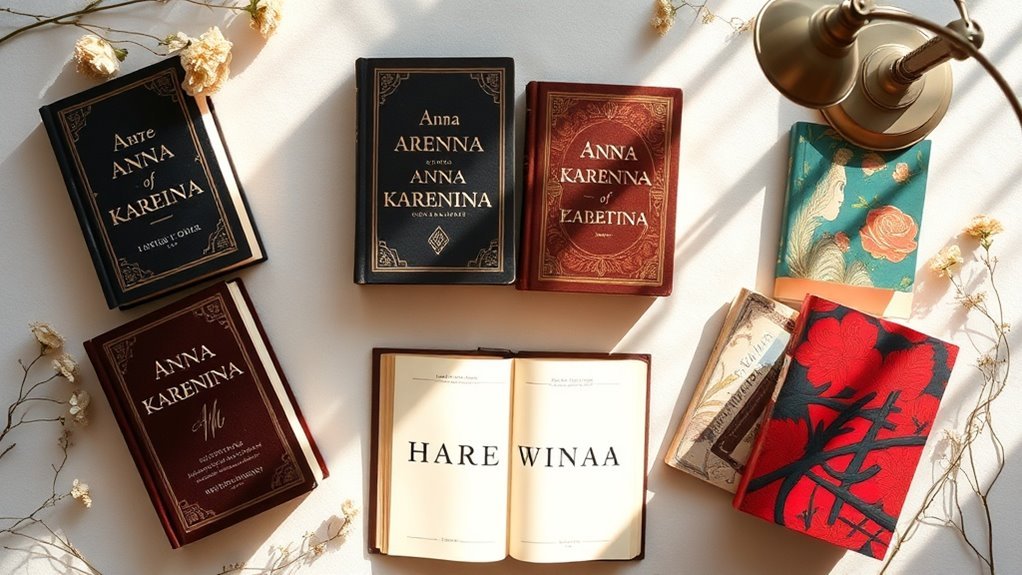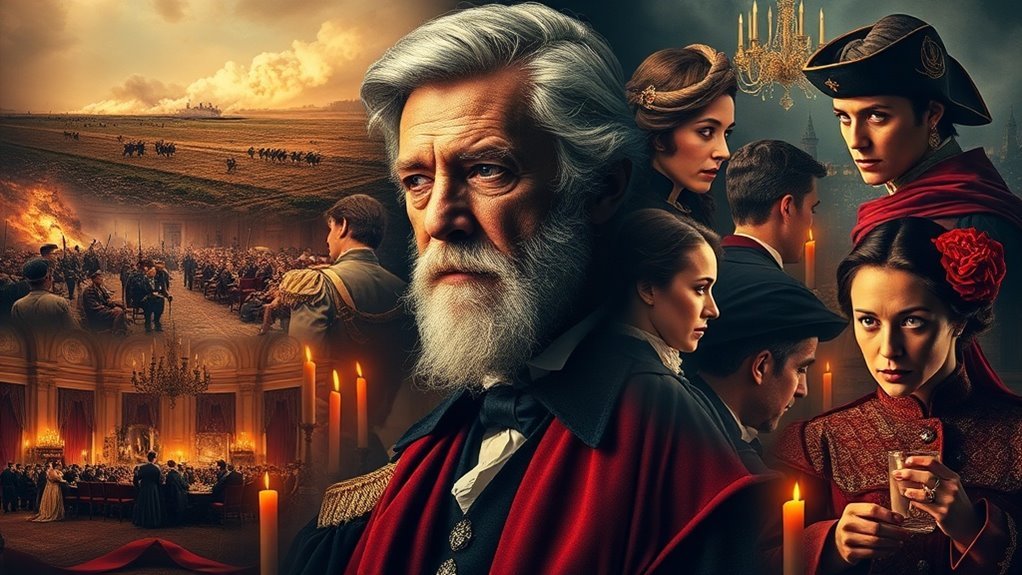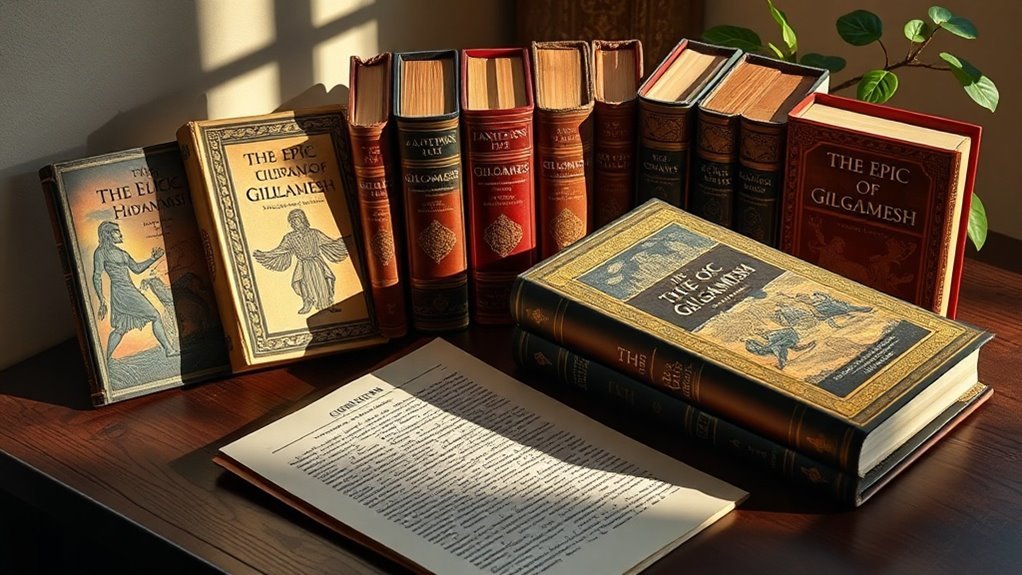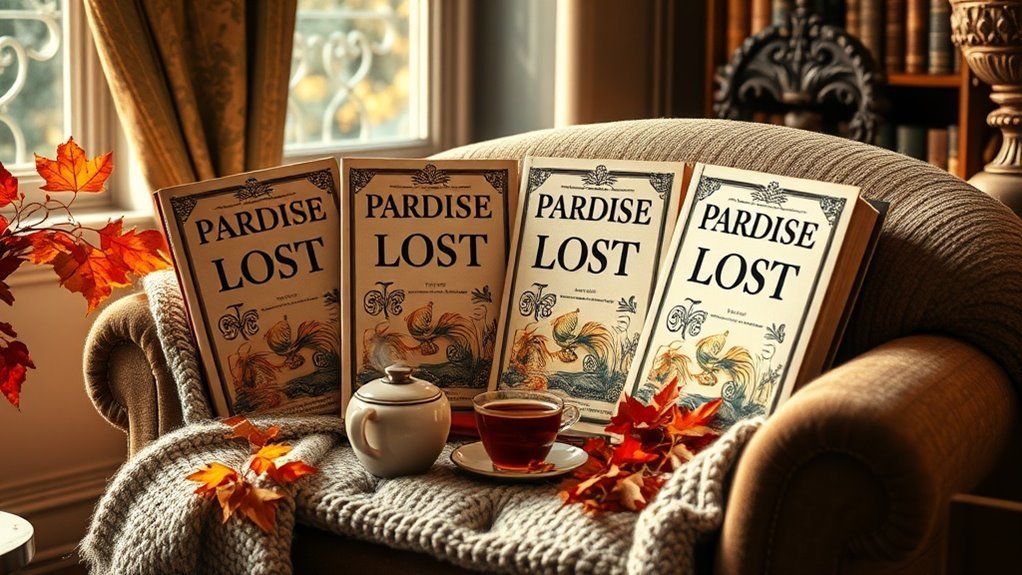If you’re looking for the best editions of “The Hunchback of Notre-Dame,” consider the Illustrated Abridged Classics for younger readers, or the Wordsworth Classics for emotional depth. Disney’s Big Golden Book offers engaging visuals, while Thrift Editions are great bargains. Each edition suits different audiences and preferences, whether you want accessibility or substantive content. Stick around to discover more options and what makes each edition special.
The Hunchback of Notre-Dame
“The Hunchback of Notre-Dame” by Victor Hugo is a stunning tale that captures the heart and soul of Paris through the eyes of Quasimodo, the bell ringer of Notre-Dame Cathedral. This poignant story explores Quasimodo’s profound yet unrequited love for the enchanting Esmeralda amidst a backdrop of societal betrayal and isolation. As you delve into this classic, you’ll be intrigued by how Hugo epitomizes both the beauty and brutality of human existence.
Main Themes:
- Unrequited Love: The agony of longing and affection that remains unreturned.
- Societal Rejection: The harsh judgment and isolation faced by those who are different.
- Compassion and Loyalty: Moments of kindness that shine brightly against darker societal norms.
Hugo’s writing style is as rich and evocative as the Parisian setting itself. His detailed descriptions and lush prose draw you into the emotional core of each character, making their struggles feel profoundly personal. Lines like, “The tragic beauty of the visible world invites us to dream,” resonate powerfully, reminding us of the juxtaposition of beauty and sorrow in life.
This edition of “The Hunchback of Notre-Dame” is a must-read not only for its compelling narrative but also for its exploration of timeless themes that remain relevant today. Are you ready to lose yourself in a story that delves deep into the complexities of love and humanity? Pick up a copy and experience the magic of Victor Hugo’s masterwork—you won’t regret it.
Notre-Dame de Paris
“Notre-Dame de Paris” is a captivating tale woven through the majestic backdrop of the cathedral itself, offering readers a unique glimpse into the heart of 15th-century Paris. Victor Hugo deftly shifts the focus from individual characters to the edifice, presenting the cathedral as both a character and a symbol of the human experience. Within this rich narrative, themes of love’s despair, fate, and the relentless passage of time emerge, inviting readers to explore the depths of human emotion amidst the stone walls and soaring towers.
Key Themes:
- Love’s Futility: Examine the tragic outcomes of unattainable love.
- Mystery and Drama: Engage with the intertwining lives of the characters in a setting full of intrigue.
- Cultural Reflection: Delve into a historical context that offers commentary on society and morality.
Hugo’s signature writing style is both poetic and profound, with a blend of detailed descriptions and philosophical musings that bring the story to life. His prose invites readers to linger on each page, making it a truly immersive experience. One cannot help but be moved by passages like, “The great cathedral, at its feet, is but a stone being.” Such lines remind us of the undercurrents of humanity that flow through the narrative, tying together the fates of all involved.
The Hunchback of Notre Dame: Illustrated Abridged Classics
Dive into the captivating world of “The Hunchback of Notre Dame: Illustrated Abridged Classics,” where the timeless tale of love, betrayal, and redemption comes to life in a beautifully condensed format. This rendition captures the essence of Victor Hugo’s original narrative, allowing young readers to grasp the heartfelt journey of Quasimodo and Esmeralda while exploring complex themes of acceptance and humanity.
Key Themes:
- The struggle for acceptance in a judgmental society
- The ambiguity of human nature and moral complexity
- The heartbreaking consequences of unrequited love
The writing style of this abridged version strikes a perfect balance between maintaining the richness of Hugo’s language and presenting it in an accessible manner for younger audiences. Its concise format invites readers to reflect on poignant moments without feeling overwhelmed. As Hugo poignantly writes, “All the world is made of faith, and trust, and pixie dust,” echoing the book’s profound belief in the possibility of hope amid despair.
The Hunchback of Notre-Dame (Wordsworth Classics)
Review of “The Hunchback of Notre-Dame”
In Victor Hugo’s timeless classic, “The Hunchback of Notre-Dame,” readers are immersed in a powerful narrative set against the breathtaking backdrop of medieval Paris. This compelling tale revolves around the tragic lives of Quasimodo, the deformed bell-ringer; Esmeralda, the spirited Romani girl; and the tormented Claude Frollo, whose obsession leads to heart-wrenching consequences. Each character’s journey intertwines in ways that explore the depths of love, acceptance, and societal judgment, making it a truly unforgettable read.
Key Themes:
- Love and Sacrifice: At its core, the story delves into the complexities of love—both romantic and platonic—and the sacrifices that accompany it.
- Societal Acceptance: The characters grapple with societal norms and prejudices, prompting readers to reflect on their own views and biases.
- Redemption and Forgiveness: As the story unfolds, themes of redemption and the possibility of forgiveness emerge, weaving a rich emotional tapestry.
Hugo’s writing is both lyrical and evocative, drawing readers into a vivid world filled with intricate details and poignant emotions. His structured narrative style captivates the reader, as he shifts seamlessly between the perspectives of each character. One particularly moving quote encapsulates the essence of the story: “The beauty of a woman is like a flower; its fragrance is fleeting, and its petals will eventually fall.” Such profound reflections enhance the emotional impact of the novel.
Ultimately, “The Hunchback of Notre-Dame” is more than just a tale of love and tragedy; it’s a profound exploration of the human condition and the societal forces that shape our lives. Whether you’re seeking to experience the depths of human emotions or simply enjoy masterful storytelling, this classic is a must-read. Embrace the journey through love, loss, and the pursuit of acceptance—pick up your copy today and immerse yourself in Hugo’s brilliant world.
Disneys the Hunchback of Notre Dame (Big Golden Book)
Embark on a captivating journey through Disney’s The Hunchback of Notre Dame (Big Golden Book), where young readers are introduced to the illustrious tales of bravery, friendship, and self-acceptance. This beautifully illustrated book offers a vibrant glimpse into the life of Quasimodo and the enchanting surroundings of Notre Dame Cathedral, captivating the imaginations of children aged 3 to 5.
Main Themes:
- Bravery and Acceptance: Learn the value of embracing one’s uniqueness through the story of Quasimodo.
- Cultural Heritage: Explore the wonders of France and the historic Notre Dame Cathedral.
- Friendship: Discover the power of connections through characters like Esmeralda and Phoebus.
Richly designed with high-quality illustrations and a structure that flows effortlessly, this book draws readers into a vivid world, making the classic tale accessible and engaging for young hearts and minds. Lines like, “What makes us different makes us special,” resonate with the audience and reinforce the story’s heartwarming messages.
Ultimately, Disney’s The Hunchback of Notre Dame (Big Golden Book) is not just a lovely addition to any child’s library; it’s a gateway to understanding themes of compassion, heritage, and courage. Make this delightful read a part of your family’s storytime collection, and inspire your children with a tale that celebrates diversity and friendship in an endearing, whimsical fashion. This book is truly worth adding to your shelves!
The Hunchback of Notre-Dame
“The Hunchback of Notre-Dame” is a captivating tale that transports readers to the streets of Paris, where the beleaguered bell-ringer Quasimodo, the enchanting La Esmeralda, and the grand Notre Dame cathedral come together in a poignant narrative of love and tragedy. As the characters grapple with society’s harsh realities, this timeless story reveals the complexities of the human heart and the struggle for acceptance in a world rife with conflict.
Main Themes:
- Love and Sacrifice: Explore unconditional love in its many forms.
- Isolation and Belonging: Delve into the struggles of those marginalized by society.
- Social Injustice: Reflect on the conflicts between the classes in 15th-century France.
Victor Hugo’s writing is both lyrical and powerful, often immersing readers in rich descriptions that evoke vivid imagery and deep emotions. His unique style invites readers to ponder the philosophical underpinnings of the narrative while being swept away by the characters’ journeys. Memorable passages, such as “The great cathedral is a kind of book, a history that you read in stone,” encapsulate the profound connection between humanity and architecture in the story.
The Hunchback of Notre Dame (Thrift Editions)
*The Hunchback of Notre Dame* is a captivating tale by Victor Hugo that explores the lives of its unforgettable characters against the backdrop of 15th-century Paris. At its heart, the story delves into themes of love, acceptance, and the complexity of human relationships, as we follow Quasimodo’s search for belonging and Esmeralda’s yearning for family.
Key Themes:
- Love & Acceptance: The quest for understanding in a world filled with prejudice.
- Loss & Sacrifice: The profound impact of choices and their consequences on individual lives.
- Social Commentary: Insights into societal values and the poignant contrast between beauty and ugliness.
Hugo’s exquisite prose immerses readers in a richly detailed world, combining emotional depth with vivid imagery. His masterful language brings to life not only the characters but also the grand Notre Dame cathedral itself, symbolizing the enduring nature of love and hope. One of the book’s poignant quotes, “What makes a monster and what makes a man?” encapsulates the essence of humanity and our moral struggles, serving as a powerful reminder of our shared vulnerabilities.
With its profound emotional resonance and intricate character development, *The Hunchback of Notre Dame* is not just a novel, but an experience that lingers long after the last page is turned. Whether you’re a fan of classic literature or new to Hugo’s work, this edition invites you to explore timeless questions about identity and acceptance. Don’t miss the opportunity to engage with a story that speaks across generations—it’s a must-read that offers insight and reflection that will stay with you.
Factors to Consider When Choosing The Hunchback of Notre Dame Books
When choosing a version of The Hunchback of Notre Dame, you’ll want to contemplate several factors that can enhance your reading experience. From your preferred edition type to the accuracy of translations, each aspect plays a vital role in how much you enjoy the story. Don’t forget to reflect on illustrations and the book’s length, as these can also impact your connection to the text.
Edition Type Preference
Choosing the right edition of “The Hunchback of Notre-Dame” can greatly enhance your reading experience, especially since each type offers distinct advantages. If you’re up for a challenge, the original French edition exceeds 900 pages and gives you the full narrative, though its length and historical context may be demanding. Alternatively, an abridged edition, like the Bantam version at 365 pages, allows for a quicker read, making it more appealing for younger audiences. Unabridged editions, such as the Collins edition, contain thorough narratives but might feel cumbersome due to lengthy digressions. Additionally, contemporary translations often provide clarity and accessibility that older versions lack. Don’t forget to reflect on the physical quality of the book, including cover design and print size, as these can impact your enjoyment.
Reading Level Consideration
Since different editions of “The Hunchback of Notre-Dame” cater to various reading levels, it’s essential to reflect on your own familiarity with classic literature and the specific content of each version. If you’re introducing younger readers, an abridged edition like the Illustrated Abridged Classics can effectively capture key plot points with engaging visuals. On the other hand, if you seek an all-encompassing experience, the unabridged Collins edition offers an in-depth exploration into character backstories and historical context, although it may challenge those looking for a quicker read. Also, consider versions with contemporary language, which enhance accessibility. Familiarity with themes like unrequited love will enrich your understanding, making your reading experience more meaningful. Choose wisely!
Translation Accuracy Importance
Understanding the importance of translation accuracy can greatly enhance your reading experience of “The Hunchback of Notre-Dame.” With Victor Hugo’s complex narrative and emotional depth, variations in translation can notably shift how you perceive the story. Accurate translations are vital for grasping the nuances in Hugo’s style, as the use of Latin and diverse linguistic techniques adds layers of meaning. Modern versions often provide footnotes and contextual explanations, enriching your understanding of historical and cultural references. However, some contemporary translations might lack the vividness of earlier editions, so it’s important to choose one that maintains the emotional intensity of the original. Opting for an unabridged edition guarantees you fully appreciate Hugo’s insights and thematic intricacies.
Illustrations and Presentation
When considering which edition of “The Hunchback of Notre-Dame” to bring into your collection, illustrations and overall presentation play a significant role in shaping your experience. Illustrated editions can truly enhance your reading by providing visual representations that make the narrative more engaging, especially for younger audiences. Pay attention to the quality of illustrations; some editions boast elaborate artwork that complements the story, while others may fall short. You’ll likely appreciate designs that enrich the emotional impact without compromising the original tale. Don’t overlook presentation elements like cover design and layout, as an aesthetically pleasing book often draws more interest. Finally, editions with annotations or footnotes can offer valuable insights, enhancing your understanding of the text’s historical and cultural contexts.
Length and Abridgment Options
Choosing the right edition of “The Hunchback of Notre-Dame” often comes down to the length of the text and whether it’s abridged or unabridged. The original French version boasts over 900 pages, providing a thorough exploration of its themes and characters. If you’re looking for a quicker read, consider the abridged editions, like the Bantam version, which condenses the story to about 365 pages while maintaining the main storyline. For those who appreciate depth, the unabridged Collins edition spans around 645 pages, including detailed digressions. You might also find illustrated abridged editions catering to younger readers, summarizing essential plot elements without the secondary details. Choose based on your preferences for depth or concise storytelling.
Character Depth Analysis
As you explore different editions of “The Hunchback of Notre-Dame,” consider the character depth that each version conveys. Quasimodo, the hunchback, epitomizes the struggle for acceptance amidst physical deformity and societal rejection, akin to Frankenstein’s Creature. La Esmeralda symbolizes innocence and resilience, traversing a world that marginalizes her despite her quest for belonging. Dom Claude Frollo offers a complex study in obsession and duality, torn between his desires and his duties as archdeacon. The cathedral of Notre Dame itself acts as a character, embodying both architectural beauty and Paris’s historical turmoil. Each character’s journey reflects themes of love, sacrifice, and the relentless pursuit of belonging, underscoring the profound depth in Hugo’s narrative.
Historical Context Relevance
Understanding the historical context of “The Hunchback of Notre-Dame” can greatly enhance your reading experience. As you explore the narrative, you’ll uncover themes of societal rejection within the tumultuous political climate of 15th-century Paris. Victor Hugo’s portrayal of the Notre-Dame cathedral serves as a powerful symbol, reflecting the era’s cultural and emotional intricacies. By recognizing the gothic architecture and the revival of medieval structures, you’ll appreciate their significance in the story. The intertwined fates of the characters against historical events showcase social hierarchies and moral ambiguity. You’ll find that the Latin phrases and cultural references enrich your understanding, offering insights into the challenges faced by individuals in that specific societal framework.
Target Audience Suitability
Exploring the different editions of “The Hunchback of Notre-Dame” helps tailor your reading experience to your specific audience. If you’re introducing this classic to younger readers, consider abridged versions like “The Hunchback of Notre Dame: Illustrated Abridged Classics” or Disney’s “Big Golden Book.” These options keep the story engaging while simplifying complex themes. For adults craving deeper insights, choose unabridged editions that investigate societal rejection and emotional struggles. If you’re looking for a blend of accessibility and depth, translations like John Sturrock’s unabridged edition enhance readability without losing substance. Keep in mind your own language proficiency as the original French text can be challenging, ensuring you select the right edition for the best experience.

